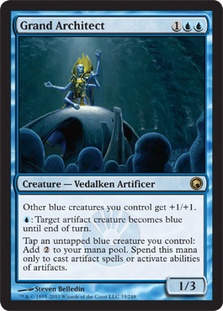First, I just want to comment on Paul Rietzl recent victory at Pro Tour Amsterdam. When I made my fake set review, which included several player cards
(and wasn’t work-safe, so we’re not linking it — T.F.)
, Paul’s was:
Paul Rietzl
2
Artifact Creature — Beast
Sacrifice an artifact: put a +1/+1 counter on Paul.
Modular 1
When Paul attacks, he acts like he sucks, but he deals the normal amount of damage based on his power.
Zoo with Punishing Fire? Thanks for the offer, but Nassif said I can borrow his Affinity deck, so I’m all set.
0/0
The ability I added to Arcbound Ravager (a card I chose to use in order to poke fun at Paul’s love of Affinity) was all about Paul’s humble and self-deprecating demeanor, which is in sharp contrast to his skill as a Magic player.
Paul told me before Pro Tour Amsterdam that if he did poorly, he was going to “fall off the train gracefully” by not attending Worlds and essentially “hang ’em up” for the time being.
I was almost overcome with joy for Paul when he won in Amsterdam. Paul and I have prepared for so many events together, traveled to so many events together, and had so much fun along the way. Paul makes every single one of the events I attend more enjoyable, and it’s great to know he isn’t going anywhere.
If nothing else, Paul’s story teaches us that a few months can change everything. This is a picture I took of Paul as his New England Patriots lost to the Baltimore Ravens in the 2010 NFL playoffs in January:

This is Paul now:

Well done, sir.
With my thoughts on the Amsterdam champ aside, let’s turn to Legacy for a moment. As Paul might say, “I’m no Nassif as a deckbuilder, and I’m no Cunningham as a writer, but here’s my article anyway.”
Grand Architect. If someone were to say the words “grand architect,” I’d think of Frank Gehry and I. M. Pei, or perhaps Ellen Page’s character in
Inception
, who was an
architect of dreams
, or perhaps the architect of the game I love so much, “Dr.” Richard Garfield.
Quick aside: I’m of the opinion “Dr.” should refer to M.D.s only. I have a J.D. (the degree of Juris Doctor), but I don’t raise my hand when someone needs medical attention and the flight attendants (or the Air Servants, as I call them) ask if there’s a doctor on the plane. Let the real doctors be doctors and the Ph.D.’s can be called “nerds” and the J.D.’s can be called “a–holes.” Nobody gets confused this way.
Getting back to Grand Architects… soon enough, when I hear those two words I’ll think of this guy:

In fact, I’ve been thinking of this guy quite a bit recently. When new cards are spoiled, sometimes one of them fits so well into an existing strategy that it immediately gets you excited about revisiting that deckbuilding space. Grand Architect just screams “Painter’s Grindstone” to me. For reference, here is the list that Ken Adams used to win StarCityGames.com Legacy Open: Minneapolis:
Creatures (14)
Lands (21)
Spells (25)

While Ken’s deck is kind of a hybrid between Bomberman (Auriok Salvagers combo) and Painter’s Grindstone (Painter’s Servant + Grindstone, obviously), I’d like to focus on the Painter’s half. This strategy has existed in Legacy for a while but is regarded by most veterans of the format as a Tier 2 combo. In other words, there’s something else you can be doing, something better, in the combo deck space, so why bother using a 1/3 creature and an otherwise useless artifact to kill the opponent?
Ken Adams’ success is something we shouldn’t ignore — but all things considered, I’m one of the folks who just doesn’t think Painter’s Grindstone is a Tier 1 combo at present. Grand Architect has a chance to change that.
What are the weaknesses of the Painter’s Grindstone combo?
-
It’s vulnerable to creature removal
and
artifact removal. - It costs six mana to pull off.
- The pieces don’t do all that much (especially Grindstone) without the other half.
Grand Architect doesn’t solve all of these problems. However, “eliminating weaknesses” and “overcoming weaknesses” are two different things. Every combo has problems and weaknesses, but the successful ones have enough speed and enough resilience to overcome those problems and be effective. Grand
Architect might add enough speed and just enough resilience to make our combo Tier 1. Then again, it might not. We’ll have to find the right list
and
get a feel for our particular local metagame to find out if it has what it takes.
Grand Architect is fully online the turn it comes into play. “Summoning sick” blue creatures can be tapped for two artifact mana just like any other blue creature, including the Architect itself. (For those of you who are new to the game, “summoning sick” is what we used to call non-haste creatures the turn they came under your control, meaning they can’t tap or attack in most circumstances. The term also briefly was used to describe the condition
that makes unattractive women seem much more attractive in a convention hall full of gamers, as in, “Dude, you must be summoning sick. She’s
maybe
a 5.”) I
If you’ve got a way to use two artifact mana, the Architect is only going to “cost” you one mana to play. The double-blue mana cost makes things a bit more complicated, especially in a deck that might otherwise want Grim Monolith, so we’ll have to keep that in mind as we build.
Another thing to note is that the Painter’s Servant
is
a blue creature, despite its border, whenever you want it to be, and without having to activate the Architect’s color-changing ability. Just name blue when the Servant comes into play. This means that if you have an Architect out, all of your Painter’s Servants are kind of free. Additionally, any other creatures you have lying around (namely Imperial Recruiter, but possibly others) become blue, too, and can tap for mana.
The lines of play that Architect opens up are very interesting. Say I’ve got a Recruiter on the battlefield, which I used last turn to tutor up a Servant or Architect. Now, I cast Architect, and immediately tap it to cast Painter’s Servant. I name blue, and now my Servant and my Recruiter can tap for two mana each. You know what costs four mana? Playing and activating Grindstone.
A turn 4 kill was always possible with our deck,
but not without playing the Painter’s Servant on an earlier turn
and exposing it to their removal.
Another thing the Architect does is give all our other blue creatures +1/+1. With Painter’s, this means all of our creatures. The turn 4 line above — where you play the Architect and use it to play the Servant — means that if they have Lightning Bolt, they have to use it on the Architect rather than the Servant, since the Servant is never smaller than 2/4 while Architect is alive. Those times you
don’t
have a Grindstone, the extra power and toughness also matters. Trinket Mages, Recruiters, Magi of the Moon — they all do really cool things and then leave behind a body or two (reminds me of O.J. Simpson’s career as an athlete). Architect brings them up to “respectable” stature to maybe trade with a Wild Nacatl or start chipping away at the control player’s life total.
Let’s walk through some initial decklists to see what we can do with the Architect.
Creatures (18)
- 3 Trinket Mage
- 4 Imperial Recruiter
- 2 Llawan, Cephalid Empress
- 1 Magus of the Moon
- 4 Painter's Servant
- 4 Grand Architect
Lands (23)
Spells (19)

This list is the most direct way of breaking the card Painter’s Servant. If we can get one out naming blue, we can do pretty much anything. Bounce their whole team (Llawan), have one=mana Counterspell/Vindicate split cards (Pyroblast/REB), pitch a land to Force of Will or Misdirection to protect the Servant (all lands in our hand are blue now), and, of course, mill their entire library (Grindstone).
Imperial Recruiter is the direct way of finding the Servant (or the Architect), and Trinket Mage for Top is the backdoor way of finding what we need. Trinket Mage for Top of course finds the Grindstone, which means Recruiter for Trinket Mage finds the Grindstone, albeit at a slow pace.
Magus of the Moon and Explosives are tools for our toolbox rather than combo pieces, but everything else is fairly linear. Aether Vial is worth considering in any list with this many creatures, but I haven’t included it in this initial sketch.
I’d also like some way to make the opponent draw a card at instant speed, so that we can combo out decks playing Emrakul, but those decks aren’t common enough to make me maindeck an answer at present.
Next let’s take that list and add Counterbalance + Top to try to a) have a good backup plan versus everyone and in particular, b) be able to protect the Painter’s Servant from popular cards like Swords to Plowshares and Lightning Bolt.
Creatures (16)
- 3 Trinket Mage
- 3 Imperial Recruiter
- 1 Llawan, Cephalid Empress
- 1 Magus of the Moon
- 4 Painter's Servant
- 4 Grand Architect
Lands (23)
Spells (21)

This version doesn’t hit as hard with a Servant out — but we’ve traded that for a much better game without the Servant and more ways to protect it. Also, the Architect helps us play and activate Tops, which is especially relevant in the early turns when every mana matters.
Moving away from Painter’s Servant for a moment, let’s consider what other decks have a use for fast artifact mana and a lord to pump their blue creatures. Affinity comes to mind.
If Affinity were still an Extended-legal strategy, I’d be more excited, since Legacy is generally harsher waters to be swimming in. That makes us want the faster, rather than the more resilient, versions of Affinity. Since Affinity is going to be slowed down too much by a three-mana 1/3, let’s try and take a page out of Merfolk’s book and use our lord (lord
s
, actually, since we get Master of Etherium as well) alongside mana disruption and counters:
Creatures (22)
- 4 Arcbound Ravager
- 2 Masticore
- 4 Etherium Sculptor
- 4 Master of Etherium
- 4 Lodestone Golem
- 4 Grand Architect
Lands (21)
Spells (15)

Have I merely managed to assemble a bad Affinity deck that plays like a bad Merfolk deck? It’s very possible. I want to get you thinking about the possibilities so that when you spot that interaction that I missed or that other combo that meshes well with one of these, you’ll have a headstart building a new deck.
I think this aggressive build has some good things going for it, even if it just isn’t powerful enough to compete for Merfolk’s turf. We might want to use Tundras and fetchlands so we can get Ethersworn Canonist into the sideboard or possibly the maindeck.
I’ll have a review of the entire Scars set and its impact on Eternal formats once the entire set is released. Thanks for reading.
–Matt Sperling
mtg_law_etc
on Twitter
